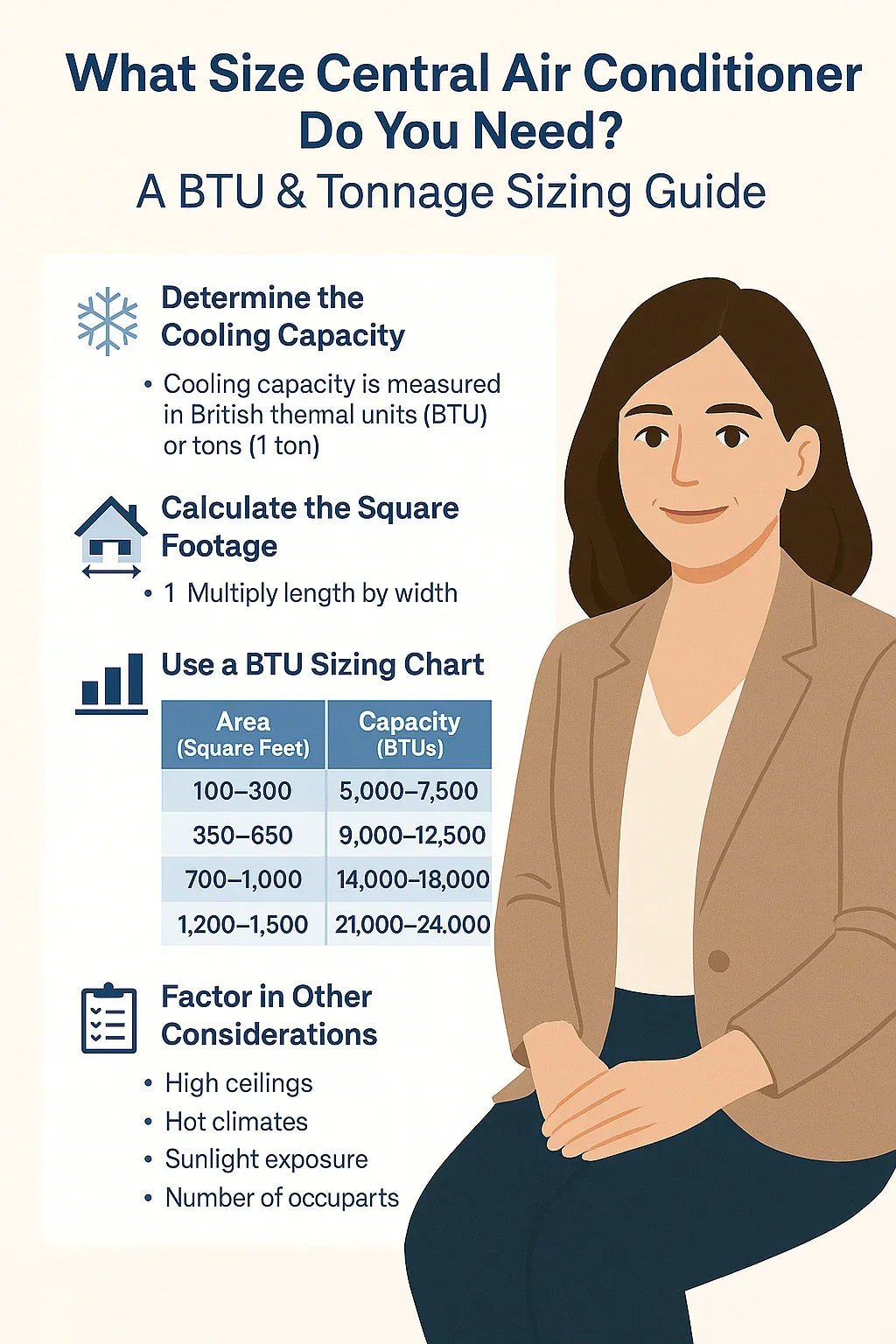🔄 Introduction: The High Cost of Getting It Wrong
Choosing the right size central air conditioner is critical. An oversized unit wastes energy and drives up costs. An undersized unit will struggle to keep your home cool, leading to discomfort and early system failure. In this comprehensive guide, we’ll show you exactly how to calculate the proper size for your home using BTUs, tonnage, climate, and layout factors.
🔊 The Basics: BTUs & Tonnage Explained
What is a BTU?
-
BTU (British Thermal Unit): The amount of energy needed to cool or heat one pound of water by one degree Fahrenheit.
-
In air conditioning, BTUs represent cooling capacity.
What is Tonnage?
-
One ton of cooling equals 12,000 BTUs per hour.
-
Common residential units range from 1.5 tons (18,000 BTUs) to 5 tons (60,000 BTUs).
🌊 Rule of Thumb Estimates
A quick sizing rule:
| Home Size (sq ft) | Approximate AC Size |
|---|---|
| 600 - 1,000 | 1.5 tons (18,000 BTU) |
| 1,000 - 1,500 | 2.0 tons (24,000 BTU) |
| 1,500 - 2,000 | 3.0 tons (36,000 BTU) |
| 2,000 - 2,500 | 4.0 tons (48,000 BTU) |
| 2,500 - 3,000 | 5.0 tons (60,000 BTU) |
Warning: Rule of thumb sizing is just a starting point. It ignores critical factors like insulation, sun exposure, ceiling height, and climate.
For detailed calculations, use Energy Star's HVAC sizing guidelines.
🔢 The Manual J Load Calculation
Manual J is the gold standard method professional HVAC contractors use to calculate proper system size. Factors considered include:
-
Square footage
-
Insulation quality
-
Window size, type, and orientation
-
Ceiling height
-
Ductwork efficiency
-
Sun exposure
-
Occupancy load
-
Internal heat gains (appliances, lighting)
A proper Manual J assessment ensures you get the most efficient, cost-effective system for your specific home.
Learn more about Manual J from ACCA (Air Conditioning Contractors of America).
🌊 The Dangers of Oversizing
Many homeowners assume “bigger is better” when it comes to AC sizing. In reality, oversizing causes:
-
Short cycling: The system turns on/off rapidly, reducing efficiency.
-
Higher humidity: Short cycles don’t allow proper dehumidification.
-
Uneven temperatures: Hot and cold spots develop.
-
Higher energy bills: Inefficient operation wastes power.
-
Shorter lifespan: Equipment wears out faster.
💔 The Problems of Undersizing
An undersized system struggles to keep up on hot days, leading to:
-
Constant running
-
Poor cooling performance
-
Excessive wear on components
-
Higher energy bills from extended runtime
🌍 Climate Zone Adjustments
Your geographic location plays a major role in sizing needs:
| Climate Zone | Adjustment |
| Hot (Florida, Texas, Arizona) | Add 10-20% capacity |
| Mild (California coast, Pacific NW) | May reduce capacity |
| Cold (Northern US, Canada) | Heating more important than cooling |
For regional climate data, visit DOE’s climate zone map.
💼 Other Sizing Considerations
🏡 Insulation Quality
-
Well-insulated homes require smaller systems.
-
Poor insulation demands higher capacity.
🌞 Window Size & Exposure
-
Large south- or west-facing windows increase cooling loads.
-
Energy-efficient windows reduce demand.
🛋 Ceiling Height
-
High ceilings increase air volume to be cooled.
🛠️ Ductwork Efficiency
-
Leaky or poorly insulated ducts waste cooling power.
🤝 Occupancy Load
-
More people generate more internal heat.
📊 Real-World Example Calculation
Home: 2,000 sq ft single-story in Atlanta, GA
-
Rule of thumb: ~3.5 tons (42,000 BTUs)
-
Manual J factors:
-
New insulation, double-pane windows
-
Moderate shading
-
2 adults + 2 kids
-
Adjusted sizing: 3.0 tons (36,000 BTUs)
This small adjustment can save hundreds annually in operating costs.
🔧 Professional Assessment Is Worth It
While online calculators and rule-of-thumb charts are useful, hiring a qualified HVAC contractor to perform a full Manual J calculation is highly recommended.
A professional assessment may cost $200-$500 but can save you thousands over the life of your system.
Find credentialed contractors through ACCA's contractor directory.
🌟 Conclusion: Right-Sizing Is Everything
Getting your AC size right isn’t just about comfort — it impacts:
-
Energy efficiency
-
Utility bills
-
Equipment lifespan
-
Indoor air quality
Take the time to calculate carefully or consult a professional. Start your shopping with trusted sources like The Furnace Outlet, which offer transparent specs and sizing information for every system.
In the next topic we will read about: SEER2 Ratings Explained: What Efficiency Means for Your Central AC Bill







